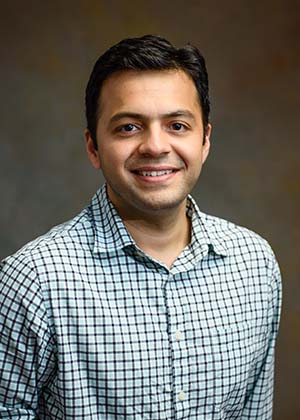Sudeep Popat
 Associate Professor
Associate Professor
161 Rich Laboratory
342 Computer Court
Anderson, SC 29625
864.656.5568
E-mail: spopat@clemson.edu
Ph.D., Chemical and Environmental Engineering, University of California, Riverside, 2010
B.E., Chemical Engineering, Sardar Patel University, India, 2006
Classes | Publications | Honors | CV
Faculty Overview
Sudeep Popat is an Associate Professor in the Department of Environmental Engineering and Earth Sciences at Clemson University. He joined Clemson as an Assistant Professor in 2016. Before Clemson, Popat was a postdoctoral research associate and then an Associate Research Scientist at the Swette Center for Environmental Biotechnology at the Biodesign Institute of Arizona State University. Popat has a Ph.D. in Chemical and Environmental Engineering from the University of California, Riverside.
Popat’s research group focuses on wastewater treatment technologies, particularly anaerobic digestion to recover energy and electrochemical technologies to recover nutrients. Ongoing projects in Popat’s lab include anaerobic co-digestion of wastewater sludge with fats, oils, and grease (FOG), focusing on understanding bottlenecks in converting long-chain fatty acids under anaerobic conditions. Within electrochemical technologies for wastewater treatment, Popat’s lab works on using electrochemical peroxide production and its applications. One area of focus is the stabilization of source-separated urine to recover nitrogen and phosphorus. Popat’s group is also part of a large effort at Clemson on disease outbreak and response, funded by the CDC. Dr. Popat focuses on wastewater-based epidemiology of emerging pathogens and the development of models to predict infection rates based on wastewater monitoring.
Popat has published >45 peer-reviewed articles and book chapters, including in high-impact journals such as Water Research, Chemical Engineering Journal, Environmental Science & Technology, and ChemSusChem, among others. Popat has been involved in projects funded >$22 million, with his share being >$2.5 million, through federal agencies such as NSF, NASA, CDC, SCDA, and SCSGC, as well as local utilities and foundations.
Class Information
For current syllabi, please search the Clemson University Syllabus Repository.
EES 3040 Wastewater Treatment Systems
EES 3050 Water and Wastewater Treatment Laboratory
Selected Publications
Arve, P.H., Mason, M., Randall, D.G., Simha, P. and Popat, S.C. 2024. Concomitant urea stabilization and phosphorus recovery from source-separated fresh urine in magnesium anode-based peroxide-producing electrochemical cells. Water Res 256, 121638.
Deaver, J.A., Kerr, C.A., Popat, S.C., 2022. Primary sludge-based blackwater favors electrical current over methane production in microbial electrochemical cells. J. Water Process Eng. 47, 102848. doi:10.1016/J.JWPE.2022.102848
Xie, A., Ladner, D.A., Popat, S.C., 2022. Electrocoagulation-electroflotation for primary treatment of animal rendering wastewater to enable recovery of fats. Chem. Eng. J. 431, 133910. doi:10.1016/J.CEJ.2021.133910
Raulerson, C.R., Popat, S.C., Husson, S.M., 2022. Water Recovery from Bioreactor Mixed Liquors Using Forward Osmosis with Polyelectrolyte Draw Solutions. Membranes (Basel). 12. doi:10.3390/MEMBRANES12010061/S1
Arve, P.H., Popat, S.C., 2021. Stabilization of Urea for Recovery from Source-Separated Urine Using Electrochemically Synthesized Hydrogen Peroxide. ACS ES&T Eng. 1, 1642–1648. doi:10.1021/ACSESTENGG.1C00194
Deaver, J.A., Soni, M.N., Diviesti, K.I., Finneran, K.T., Shankar, V., Popat, S.C., 2021. Taxonomic and Functional Variations Induced by an Overloading Event in Anaerobic Codigestion of Municipal Wastewater Sludge with Fats, Oils, and Grease. ACS ES&T Eng. 1, 1205–1216. doi:10.1021/ACSESTENGG.1C00086
McMahan, C.S., Self, S., Rennert, L., Kalbaugh, C., Kriebel, D., Graves, D., Colby, C., Deaver, J.A., Popat, S.C., Karanfil, T., Freedman, D.L., 2021. COVID-19 wastewater epidemiology: a model to estimate infected populations. Lancet Planet. Heal. 5, e874–e881. doi:10.1016/S2542-5196(21)00230-8
Xie, A., Deaver, J.A., Miller, E., Popat, S.C., 2021. Evaluation of electrical current production in microbial electrolysis cells fed with animal rendering wastewater. Chemosphere 285. doi:10.1016/J.CHEMOSPHERE.2021.131547
Xie, A., Deaver, J.A., Miller, E., Popat, S.C., 2021. Effect of feed-to-inoculum ratio on anaerobic digestibility of high-fat content animal rendering wastewater. Biochem. Eng. J. 176, 108215. doi:10.1016/J.BEJ.2021.108215
Murawski, E., Kananizadeh, N., Lindsay, S., Rao, A.M., Popat, S.C., 2021. Decreased gas-diffusion electrode porosity due to increased electrocatalyst loading leads to diffusional limitations in cathodic H2O2 electrosynthesis. J. Power Sources 481, 228992. doi:10.1016/J.JPOWSOUR.2020.228992
Xie, A., Popat, S.C., 2020. Electrochemical ammonia stripping from non-nitrified animal rendering wastewater. Chem. Eng. J. Adv. 3, 100020. doi:10.1016/J.CEJA.2020.100020
Awards & Honors
Young Investigator Oral Presentation, American Society for Microbiology General Meeting, 2014
Discovery Award for Best Scientific Paper, International Society for Microbial Electrochemistry and Technology, 2012
Air & Waste Management Association Scholarship, 2009
Krieger & Stewart, Inc. Fellowship, 2009

